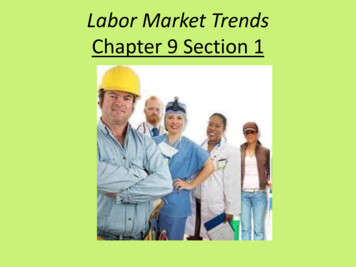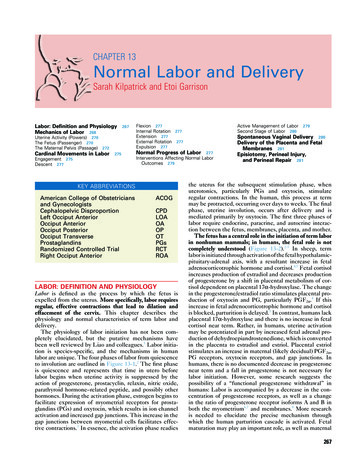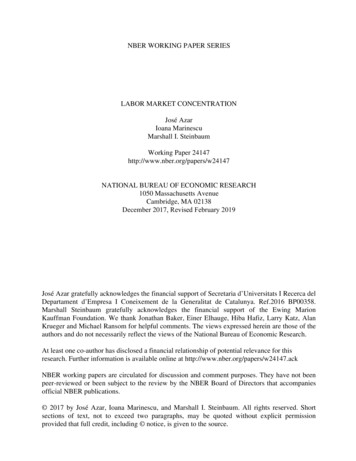
Transcription
Labor Market TrendsChapter 9 Section 1
The Labor Force Economics define the labor force as all nonmilitarypeople who are employed or unemployed.
Employed Are 16 years or older andmeet at least one of thefollowing requirements:– They worked a least one hourfor pay within the last week– They worked 15 or morehours without pay in a familybusiness– The held jobs but did notwork due to: IllnessVacationsLabor disputesBad weather.
Unemployed Are 16 years or olderand meet the followingcriteria:– They do not have a job– They have activelylooked for work in theprior 4 weeks– They are currentlyavailable for work
Temporary Employment Contingent employment– Temporary orpart-time employment.– Flexible workarrangements.– Easy discharge due to thelack of severance pay fortemporary workers.– Temporary workers areoften paid less and receivefewer benefits than theirfull-time counterparts.– Some employees prefertemporary arrangements.
How does being unemployed differfrom not being part of the labor force?Total U.S.PopulationTotal Civilian,noninstitutionalizedU.S. PopulationNon-labor ForceTotal U.S. labor forceEmployedUnemployedMilitaryinstitutionalized
Occupational Trends The economy of theUnited States hastransformed from amainly agriculturaleconomy in the 1800s, toan industrial giant in the1900s. The computer chip hasrevolutionized theeconomy since itsintroduction in the late1900s.
Occupational Trends Overall, the United Statesis shifting from amanufacturing economyto a service economy. As service jobs increase,the nation is losingmanufacturing jobs. Demand for skilled laboris rising, and the supply ofskilled workers isincreasing to meet thedemand.
Describe the changes in the U.S. economyduring the period shown on the graph.
Women in the Workforce Overall, the number ofwomen in the work forcehas increased from about38 percent of all womenin 1960 to about 58percent of all women in1995. More women are:––––Getting a college educationNot getting marriedNot having childrenWorking in “Male” jobs
By what percent will the number of womenin the workforce have changed between1960 and 2006?
Trends in Wages and Benefits Earnings for college graduateshave increased– Earnings for workers withoutcollege degrees havedecreased. Benefits now make up about28 percent of totalcompensation in the economy For employers– Rising benefits costs raise thecost of doing business– Decrease profits.– Turns them to contingentemployment to curb benefitscosts.
Why might wages for workers in retailbe much lower than those for workersin construction?
College Education Getting a college degreegreatly is now more of anecessity rather than aluxury The learning effect– Education increasesproductivity and results inhigher wages. The screening effect– The completion of collegeindicates to employers that ajob applicant is intelligent andhard-working– There maybe a bias whenhiring or not hiring workers
Education and Income Potential earnings increase with increasededucational attainment.
Disturbing Trends inCollege Education National high Schoolgraduation rate is about 86%– Rochester (MI) Schools 93%– Rochester (NY)Schools– 6 out of 10 enter a 4 year53.5%university– Detroit Public Schools 79%– The rest go to a two yearcommunity college Only 68% of high schoolstudents attend college 30% of students drop out in– Rochester (MI) Schools 95% their 1st year of college– Rochester (NY) Schools 14%– About less than 2/3 of theor NA68% will finish with a degree– Detroit Public Schools 41%
Disturbing Trends in College Education Only 68 percent of studentswho start at college finish Bachelors Degree (4 Years)– 25-30% of the overallpopulation Masters Degree (6 Years)– 9% of the overallpopulation Doctorate or professionaldegree– 2% of the overallpopulation
The College AthleteDoes going to college equal financial success? Statistics describe how a collegedegree increases the chance of ahigh paying job. There are more than 460,000college athletes– Fewer than 2 % will go pro– Most student-athletes dependon academics to prepare themfor life after college Popular majors forcollege athletes are– Communications– Social Science– Undeclared
College Academics vs.Sports Describe the type of athlete majoruniversities are recruiting? What “extra” help are theseathletes getting? What are some of the deficiencyscores these athletes have? Why is it mostly sports likebasketball and football which havethis problem? In your opinion, what couldpossibly be done about this issue?
Labor and Wages
Supply and Demand in the LaborMarketLabor Demand The higher the wage rate, thesmaller the quantity of labordemanded by firms andgovernment.Labor Supply As wages increase, the quantityof labor supplied also increases.Equilibrium Wage The wage rate that producesneither an excess supply ofworkers nor an excess demandfor workers in the labor market iscalled the equilibrium wage.
Explain how the outcome of this scenarioaffects (a) the cooks, (b) the restaurants.Cooks are paid less than theirproductivity ( the value of output).A new restaurant opens in town,offering higher wages for cooks.Other restaurants raise wages forcooks to compete for scarce labor.Cooks are paid closer to theirproductivity (the value of output).
Explain why a stable wage meansstable restaurant prices.
Wages and Skill Levels Wages vary according toworkers’ skill levels andeducation. Jobs areoften categorized intothe following dProfessional
Unskilled Labor Unskilled laborrequires:– No specialized skills– Education– Training. Examples:– Waiters– Messengers– Janitors
Semi-skilled Labor Semi-skilled laborrequires:– Minimal specialized skillsand education. Example:– Fork-lift operator
Skilled Labor Skilled labor requires:– Specialized skills andtraining. Examples:– Auto mechanics– Plumbers
Professional Labor Professional labordemands:– Advanced skills andeducation. Examples:– Lawyers– Doctors– Teachers
Give reasons to explain why the supply ofdoctors is low and the supply ofconstruction workers is high?
Wage Discrimination The Equal Pay Act of 1963– Declared that male and femaleemployees in the same workplaceperforming the same job had toreceive the same pay. Title VII of the Civil Rights Act of1964– Forbids job discrimination on thebasis of: RaceSexColorReligionnationality. Pay Levels for Minorities As the figure to the right shows,racial minorities tend to earnlower pay than white men.
Pay for Women Despite these protections– American women todayearn about 75 percent ofwhat men earn. Reasons women don’t gethired include:––––PregnancyWorking part-timeDistracting to menLack of cultural respect Racial ethnicity
2006 Basketball PlayersNBA vs. WNBAShaq 20 MillionSue Bird 87,000
2006 Golf PlayersPGA vs. LPGATiger Woods 11.9 MillionAnnika Sorenstam 2.5 Million
2006 Tennis PlayersATP vs. WTARoger Federer 8.3 MillionMaria Sharapova 3.8 Million
2006 Football PlayersNFL vs. WPFLMichael Vick 23.1 MillionStacy Agee 100 Per Game
According to the graph, whichgroup has the lowest earnings?
Organized LaborChapter 9 Section 3
Occupational Trends A labor union is anorganization of workersthat tries to improve:– working conditions– Wages– benefits for its members Less than 14 percent ofU.S. workers belong to alabor union.– This number keepsdropping
Why Unions Grew The union movementtook shape over thecourse of more than acentury. The 1935 National LaborRelations Act, also knownas the Wagner Act:– Gave workers the right toorganize– Required companies tobargain in good faith withunions.
What is the trend in unionmembership today?
Why Unions are Declining Several factors have ledto declines in unionmembership since the1950s:– “Right to Work” Laws– Economic Trends– Fulfillment of UnionGoals
“Right to Work” Laws The Taft-Harlety Act (1947) allowed states to pass rightto-work laws. These laws ban mandatory union membership at theworkplace.
Economic Trends Unions have traditionallybeen strongest in themanufacturing sector– Blue-collar workers Blue-collar jobs havebeen declining in number– The American economybecomes more serviceoriented.– Globalization– More women in theworkforce
Fulfillment of Union Goals Union membership hasdecreased simplybecause their goalshave been fulfilled byother organizations. The government has setstandards for workplacesafety– More benefits beingprovided by both privateand government sources
Unions and Negotiations Collective bargaining isthe process in whichunionand companyrepresentatives meet tonegotiatea new labor contract.– Wages and Benefits– Working Conditions– Job Security
Wages and Benefits The Union negotiateson behalf of allmembers for––––Wage rateOvertime ratesPlanned raisesBenefits
WorkingConditions Working conditionsinclude––––SafetyComfortWorker responsibilitiesOther workplace issues These are all negotiatedand written into thefinal contract
Job Security One of the union’sprimary goals is tosecure its members’jobs. The contract spells outthe conditions underwhich a worker may befired.
Labor Strike If no agreement is metbetween the union andthe company– The union may ask itsmembers to vote on astrike. A strike– An organized workstoppage intended to forcean employer to addressunion demands.– Strikes can be harmful toboth the union and thefirm.
Labor Mediation To avoid the economiclosses of a strike, a thirdparty is sometimes calledin to settle the dispute. Mediation– A settlement technique inwhich a neutral mediatormeets with each side to tryand find an acceptablesolution that both sideswill accept.
Labor Arbitration If mediation fails, talksmay go into arbitration Arbitration– A settlement techniquein which a third partyreviews the case andimposes a decision thatis legally binding for bothsides.
Market Labor Demand The higher the wage rate, the smaller the quantity of labor demanded by firms and government. Labor Supply As wages increase, the quantity of labor supplied also increases. Equilibrium Wage The wage rate that produces neither an excess supply of workers nor an excess demand for workers in the labor market is










